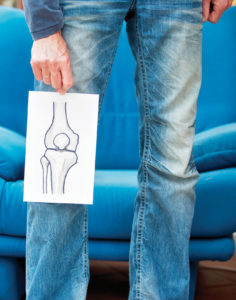 Arthritis causes wearing away of our joints. Some of the common arthritic symptoms are joint pain, stiffness, swelling, stiffness and fatigue. One of the main types of arthritis is osteoarthritis (OA) also referred to as “wear and tear” arthritis. With OA, wear and tear damages the cartilage in the joints causing them to lose their smooth gliding action and results in friction or rubbing of the ends of our bones. Greater than 120 million people in the US have arthritis.
Arthritis causes wearing away of our joints. Some of the common arthritic symptoms are joint pain, stiffness, swelling, stiffness and fatigue. One of the main types of arthritis is osteoarthritis (OA) also referred to as “wear and tear” arthritis. With OA, wear and tear damages the cartilage in the joints causing them to lose their smooth gliding action and results in friction or rubbing of the ends of our bones. Greater than 120 million people in the US have arthritis.
When arthritis affects the neck, back, hands, feet or hips, difficulties arise when trying to get through even the most menial daily tasks. The surrounding muscles may begin to tighten as they try to overcompensate for the pain and protect the injured area. These tight muscles can create tension headaches and limit range of motion. Most people may find that there is little to no relief with over the counter nonsteroidal anti-inflammatory drugs (NSAIDs), like ibuprofen.
Your Knees
Walking, standing and exercising put a lot of strain on our knees. For example, a person that weighs 150 lbs. walking up a flight of stairs will put approximately 500 lbs. of pressure on their knees with each step. Not only is the knee one of the most intricate of all the joints in the body, but they are also the most susceptible to arthritis. Multiple types of arthritis affect the knees, but osteoarthritis is by far the number one type that surpasses all others.
What is Osteoarthritis (OA) of the Knee?
Positioned between the three bones of the knee (the femur, tibia, and patella) the articular cartilage provides a smooth gliding surface and acts as a shock absorber. This cartilage is smooth and resilient but susceptible to wear and tear. Once the cartilage begins to break down it is difficult to stop and often the cartilage breaks down completely and wears away. This can cause soreness, swelling, and stiffness, and it is the beginning stages of osteoarthritis, or bone rubbing against bone, which in turn causes bone spurs and a great deal of discomfort.
Osteoarthritis develops slowly, and the often the pain becomes worse with time. This type of arthritis is also known as degenerative joint disease, because it is often associated with the aging process. But occasionally, this process can also affect younger people too. The pain can be debilitating and interfere with daily activities, affect your ability to work and create limited range of motion in your life.
Dr. Joseph Borrelli Jr. is Board Certified in orthopedic surgery and has been in clinical practice for more than 20 years. An accomplished author, researcher, and clinician, he has published numerous clinical and scientific articles, including several evaluating OA and has won awards for teaching and for compassionate patient care.
Dr. Borrelli specializes in the treatment of arthritis, including replacement of the hip, knee, elbow and shoulder, as well as osteoporosis, fragility fractures, and post-traumatic reconstruction. He is a Fellow of the American Academy of Orthopaedic Surgeons and an active member of the Orthopaedic Trauma Association.
Q: What if an individual is trying to heal their arthritis on their own? What would you say to them about their quality of life and why surgery might be essential?
A: First of all, it is important to remember that articular cartilage has no blood supply. The cells that make the cartilage are nourished by the synovial fluid; the hydrostatic pressure of the joint influences the health and pathological condition of arthritis. Once the cartilage is damaged, it wears away, and there is very little we can do to reverse the process. We can slow the wear and tear down and try to remove what’s causing the degenerative effect, but it will continue to worsen over time.
The wear and tear process can be slowed often by weight reduction, strengthening the muscles surrounding the joints, and by minimizing or reducing activities that put excessive weight on the knee joints. NSAIDs and at times corticosteroid or materials to supplement the cartilage can be injected into our knees in an effort to slow the progression or mask the symptoms, but these are temporary fixes. Wear and tear arthritis is similar to a car tire; once the tread is worn away, we need to replace the tire. Surgery removes the degenerative cartilage and a portion of the underlying bone and replaces them with metal and plastic to restore the smooth surfaces and normal relationships between the bones. Each joint is sized and fitted precisely to the patient’s anatomy.
Q: What are the primary reasons a patient needs knee replacement surgery?
A: If a patient has unrelenting pain and has exhausted all conservative means of care, they need surgery to improve their quality of life and get relief from the debilitating pain. However, we don’t rush into any surgery; we exhaust all other means and make the decisions based on the individual’s lifestyle, goals and severity of discomfort.
When the knees begin to bow inward, or for females, they often become knocked kneed, we need to correct this as well to improve gait and to alleviate permeating pressure on the hips, back and ankles, which can cause more degeneration in those areas. When a patient cannot straighten their leg all the way due to limited flexion, extension, and contraction, we recommend surgery. The two preeminent indicators for knee replacement are unrelenting pain and decreased mobility/stiffness. Surgery is favorable because knee joint replacement improves both of those elements. The patient will not be living in excruciating pain, and the knee will function as normal within a short period of time after therapy.
Q: What should a patient expect as far as recovery and physical therapy after surgery?
A: Total knee replacements are generally cemented into place, so it’s an extremely secure and stable device. My patients are walking the hallway the day after surgery. We supply physical therapy immediately post-op that’s tailored to each patient specifically. I often let patients do most of their PT on their own, but many will participate in outpatient physical therapy to maximize their outcomes. These therapeutic training sessions will improve mobility, range of motion, and restore a normal gait for the patient so that their recovery is quick and efficient.
It’s important for patients to know that these devices are made out of polyethylene (plastic) and incredibly strong metals which when placed correctly will likely last for a very long time. There is now evidence that after 17 years, 97% of total knee arthroplasties are still in place. The longevity is incredible; the majority of individuals will never need another knee replacement surgery in their lives.
Dr. Borrelli’s Education
• Doctor of Medicine – University of South Florida, Morsani College of Medicine; Tampa, Florida
• Residency
• Orthopedic Surgery – University of South Florida; Tampa, Florida
• Orthopedic Surgery – Hospital for Special Surgery, Weill Cornell Medical College; New York, New York
• Fellowship
• Orthopedic Trauma – Tampa General Hospital, University of South Florida; Tampa, Florida
Now accepting new patients age 18 and older. Most major insurance plans are accepted.
BayCare is a leading not-for-profit health care system that connects individuals and families to a wide range of services at 15 hospitals and hundreds of other convenient locations throughout the Tampa Bay and central Florida regions. Inpatient and outpatient services include acute care, primary care, imaging, laboratory, behavioral health, home care, urgent care and wellness. Our mission is to improve the health of all we serve through community-owned, health care services that set the standard for high-quality, compassionate care. For more information, visit www.BayCare.org.
BayCare Medical Group
Orthopedic Surgery
4211 Van Dyke Road, Suite 200
Lutz, FL 33558
Phone: (813) 264-6490 | Fax: (813) 443-8143
2102 Trinity Oaks Blvd., Suite 202
Trinity, FL 34655
Phone: (813) 264-6490 | Fax: (813) 443-8143
BayCare.org
Check Also
Revolutionizing Healthcare: Exploring Regenerative Medical Treatments at QC Kinetix
By Daniel Sucherman, MD In recent years, the field of regenerative medicine has emerged as …
 Central Florida Health and Wellness Magazine Health and Wellness Articles of the Villages
Central Florida Health and Wellness Magazine Health and Wellness Articles of the Villages


